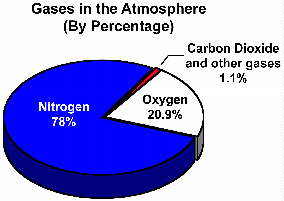 |
|||||
| Home | Research | For Teachers | HISTORY Level 1 Level 2 Level 3 |
PRINCIPLES Level 1 Level 2 Level 3 |
CAREER Level 1 Level 2 Level 3 |
| Gallery | Hot Links | What's New! | |||
| Web Administration and Tools | |||||
 |
|||||
| Home | Research | For Teachers | HISTORY Level 1 Level 2 Level 3 |
PRINCIPLES Level 1 Level 2 Level 3 |
CAREER Level 1 Level 2 Level 3 |
| Gallery | Hot Links | What's New! | |||
| Web Administration and Tools | |||||
![]()

Humans can survive for weeks without food; days without water; however, we can only
survive for minutes without oxygen. While the percentage of oxygen in the
atmosphere remains fairly constant up to 70,000 feet, the available amount of oxygen to
sustain mental and physical alertness decreases above 10,000 feet. The atmosphere is
primarily nitrogen (78%) with oxygen comprising 20.9 percent of the atmosphere.
The atmosphere is generally considered to exist up to 100,000 feet (above this altitude
the atmosphere is virtually a vacuum until reaching outer space). One-half of the
atmosphere is contained from 18,000 feet to the earth's surface (the other 50 percent is
from 18,000 feet to 100,000 feet). At sea level, the pressure of the atmosphere is 14.7
pounds per square inch (psi). At 18,000 feet the pressure is 7.34 psi. By 34,000 feet, the
pressure is reduced to one-half the value at the 18,000 foot level (3.62 psi). It is this
reduction in pressure (or in other words, the less dense air) that causes hypoxia.
Hypoxia is the effects of an insufficient supply of oxygen to the body. Every person can
have different symptoms when suffering from hypoxia (U.S. Air Force aircrews are required
to take an altitude chamber ride every three years to reinforce and identify their hypoxic
symptoms). Some of the common symptoms are: lightheaded sensation, dizziness, reduced
vision, and euphoria.
The early signs of hypoxia generally begin at 10,000 feet. U.S. Air Force aircrews must
use supplemental oxygen when the cabin pressure of the aircraft reaches this altitude.
(NOTE: The cabin altitude of an airliner and other transport aircraft by design will climb
no higher than 8,000 feet.) Without supplemental oxygen, your blood has about 90% of its
normal oxygen level at 10,000 feet.
Time of Useful Consciousness
This is the time available to an aircrew member to recognize they are suffering from
hypoxia and to take appropriate action (put on an oxygen mask and/or descend the aircraft
below 10,000 feet).
The Time of Useful Consciousness is a function of altitude. At 20,000 feet, an average
individual will have 5 to 12 minutes. At 25,000 feet, this time is reduced to 3 to 5
minutes. At 30,000 feet only 1 to 2 minutes are available. By 40,000 feet, the average
individual will have only 9 to 15 seconds (basically this represents the oxygen that was
in their system before the exposure to 40,000 feet).
Send all comments to ![]() aeromaster@eng.fiu.edu
aeromaster@eng.fiu.edu
© 1995-98 ALLSTAR Network. All rights reserved worldwide.
| Funded in part by | Used with permission From 90th Fighter Squadron "Dicemen" Aviation |
Updated: February 24, 1999